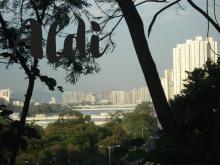The original Shing Mun River originated at Needle Hill and flowed into the former Tide Cove (Sha Tin Hoi), which was a shallow bay. During the 1970s, Tide Cove was reclaimed and transformed into Sha Tin New Town. To support this development, the river was extended via a 7 km long, 200m wide artificial channel situated centrally within the area, allowing it to discharge into Tolo Harbour. Additional rivers that previously emptied into Tide Cove have since become tributaries of the Shing Mun River, typically in the form of concreted nullahs.
The Shing Mun River channel begins at the Tai Wai area, passes through the Sha Tin town centre, and ultimately flows into Tolo Harbour. Its three principal tributaries are the Tai Wai Nullah, Fo Tan Nullah, and Siu Lek Yuen Nullah. The river is bordered by high-rise residential, commercial, and industrial buildings, as well as various village-type developments, such as City One Shatin and Wo Che Estate. Multiple bridges have been constructed to link both sides of the Shing Mun River.
The Shing Mun River mainly drains storm water from Sha Tin but is also popular for recreation. Pedestrian promenades line both banks, and various trees such as Chinese Banyan and cotton trees are planted along the riverside.
Water sports like rowing, canoeing, kayaking, and dragon boat racing are common. The river features three boathouses at Yuen Wo Road and Shek Mun, and its 2000-metre stretch meets regatta standards.
The Shing Mun River was once heavily polluted from the indiscriminate discharges from livestock, industrial, commercial and domestic sources. At that time, hardly any living creatures were found in the river.
Since 1993, Shing Mun River's Water Quality Index has improved from bad to good, with fish and invertebrates returning. Bioremediation and dredging in 2001 further enhanced the environment, but pollution from Tolo Harbour still backflows into the river at high tide, causing contamination.
Source: Wikipedia
